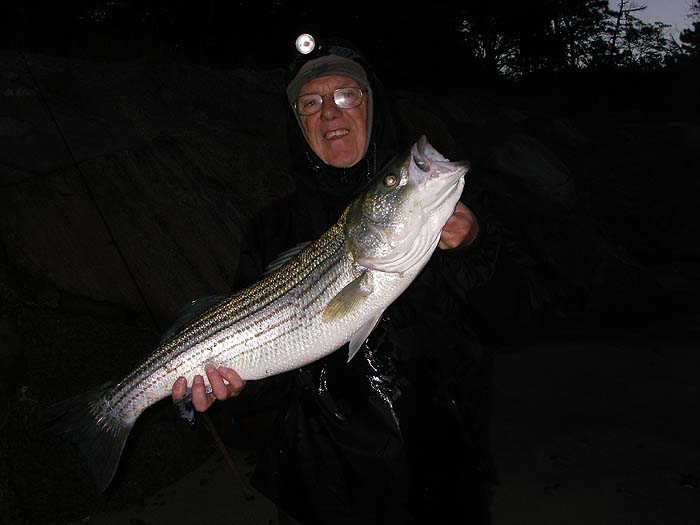

Catch Fish with
Mike Ladle
Information Page
SEA FISHING
For anyone unfamiliar with the site always check the FRESHWATER, SALTWATER and TACK-TICS pages. The Saltwater page now extends back as a record of over several years of (mostly) sea fishing and may be a useful guide as to when to fish. The Freshwater stuff is also up to date now. I keep adding to both. These pages are effectively my diary and the latest will usually be about fishing in the previous day or two. As you see I also add the odd piece from my friends and correspondents if I've not been doing much. The Tactics pages which are chiefly 'how I do it' plus a bit of science are also updated regularly and (I think) worth a read (the earlier ones are mostly tackle and 'how to do it' stuff).
Cape Cod 2
One of the main objectives of our recent trip to Cape Cod was to try and catch a striped bass. As I said before, we'd been fed to bursting point with information from our pals in B.A.S.S. so we had a pretty good idea what sort of gear to take with us (the rods and reels were more or less our normal UK bassing tackle). However, being told about it isn't quite the same thing as doing it so we were more than a little doubtful of what we were likely to encounter.
It seemed sensible to begin at the beginning by using the ubiquitous soft plastics. A quick bit of instruction from our American buddies on the sea shore and we were away. Or were we? I immediately revealed my lack of experience by tackling up with my usual 20lb nylon trace. One of the local lads gave me a 'Tsunami' curly tail shad of the same type that he was using (they were extremely generous and helpful anglers) and sure enough, after a few lifts of the rod tip I was into a decent striper. I played the fish rather tentatively despite being told by my 'instructor' to "wind it in" and just as I had gained the upper hand and was thinking "It's my first striped bass!" it was gone. The trace had parted at the loop, presumably worn through in the struggle. I was gutted. I've never had a loop break before so it was a real disappointment. Worse was to come. I was given another shad - bounce, bounce, bounce and I was in again. This time it proved to be a double figure bluefish. A real beauty. Jeez did it go! Again I fought my fish to the surface, it thrashed, it jumped, it bit through the trace. I was double gutted! I hadn't got the neck to take another of their shads, although one was offered, so on went one of my own jigheads with a nice wiggly plastic tail. It worked and I was in again - another bluefish hurtled off against the clutch. Third time lucky? Not a chance. It came unstuck. I could have wept. I felt like a complete novice. What a disastrous start. I was not the only one to suffer. Alan, fishing further along the beach, had hooked a good fish, probably a big striper, on a plug. It stripped off lots of line against the clutch and plunged into the rocks of a boulder jetty, once more he was gutted by the loss. Things, as they say, could only get better.
At least we got most of our losses over early. For the rest of the trip the traces were 40lb nylon and if bluefish were the target a short length of wire was added. It wasn't very long until we'd all caught bass. The interesting thing was the diversity of tactics that were effective. Sure the plastic shads, both paddle tails and curly tails worked well in the tide rips but we also had fish on plugs and most excitingly on poppers. We were never quite certain what would take a lure next because often bluefish and bass seemed to shoal together and both attacked lures from sea bed to surface. Many of the local anglers fished with fly gear and we saw several double figure stripers landed by fly men in the course of our stay.
For me, the most interesting events involved slightly 'off the wall' tactics. On the second or third day of our stay we found out that bass and bluefish often drove river herrings (they look like what they sound like) onto the beach by their frenzied attacks. The herrings can't be used for bait because they are a protected species and there are heavy penalties even for possession. Few shore anglers seemed at all interested in using bait but it appeared to me that it had potential. One day later on in the holiday (I can be a bit slow on the uptake) I decided to try freelining a fillet of bluefish. I sliced off a good sized wedge (perhaps 10"x6") progged the thin end onto an 8/0 circle hook and lobbed it out. It was only minutes before I felt a couple of knocks followed by a strong run with line pouring off the spool. After the fish had gone perhaps five or six yards I flicked over the bale arm and waited for the line to tighten. It tightened and the fish just kept going into a screaming run. After a bit of a tussle I found myself returning a nice twelve pound striper - success! The freelined bluefish baits proved to be effective for both of our target species and clearly had huge potential but we had only limited chances to exploit the knowledge before we returned home. At times drifting weed made bait fishing very tricky so it was not always the perfect tactic.
My second 'new approach' was perhaps the most interesting of all (well to me anyway). It was virtually our last day. Alan and I had trudged miles along a soft sandy beach in the blazing sun, casting and retrieving various lures without success. There were one or two short boulder groynes projecting a little way from the beach and between them weed had collected in vast amounts along the water's edge. We noticed that, among the drifting weed, were good numbers of small fry dimpling the surface and occasionally spraying out. It reminded me of certain spots in Dorset where bass sometimes come close in to feed on Idotea. Was it possible that striped bass could be lurking in the two feet of murky, weed laden water and trying to make a meal of the fry? I decided to see whether a weedless Slug-Go lure might be a possibility. Sure enough the 'Texas Rigged' soft plastic 'worm' was pretty well weedless. I flicked it a couple of yards out to the edge of the drifting crap and inched it back at snail's (or should it be slug's) pace. Suddenly the water exploded as a striper siezed the lure, hooked itself and set off for the horizon. Magic! Alan, who was fishing a short way to my left, came along and helped me to land the fish, probably a double but no monster in striped bass terms. Nevertheless, it was one of those catches that you store away in your memory to be used should the same conditions occur again.
All in all it was a very successful trip and we learned a lot about catching striped bass. If there's a next time I'm sure that we'll do better and catch bigger fish. Next time I'll say something about the other half of the fishy double act, the bluefish. If anything catching them was even more fun than seeking the mighty stripers.
I'm in!

Got one!

Steve's got one!
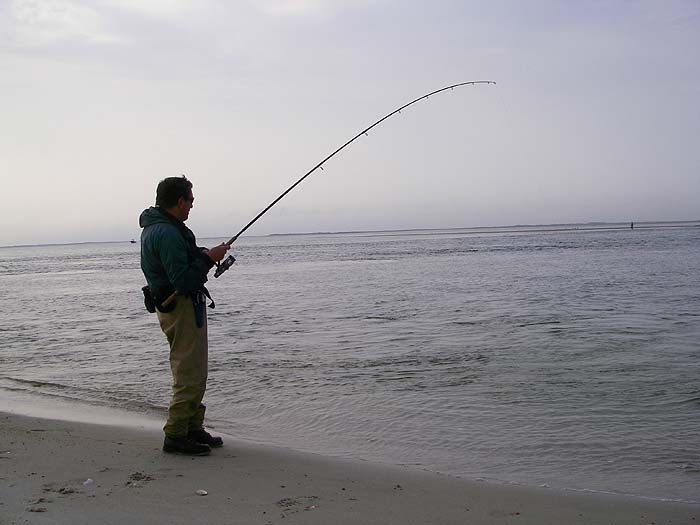
Phew!
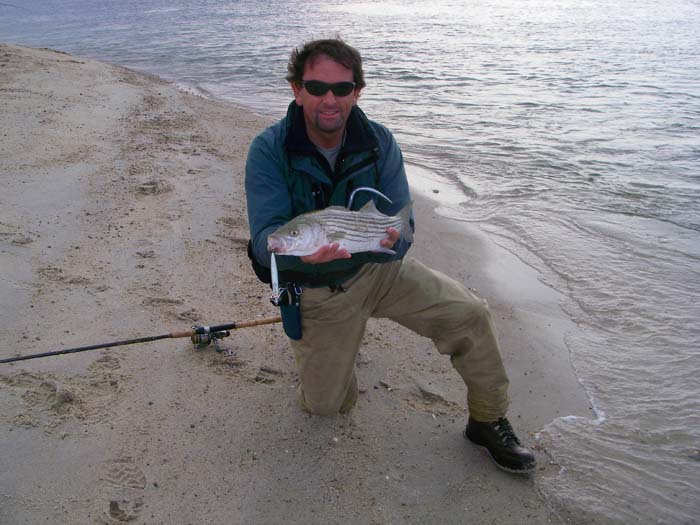
Alan's turn.
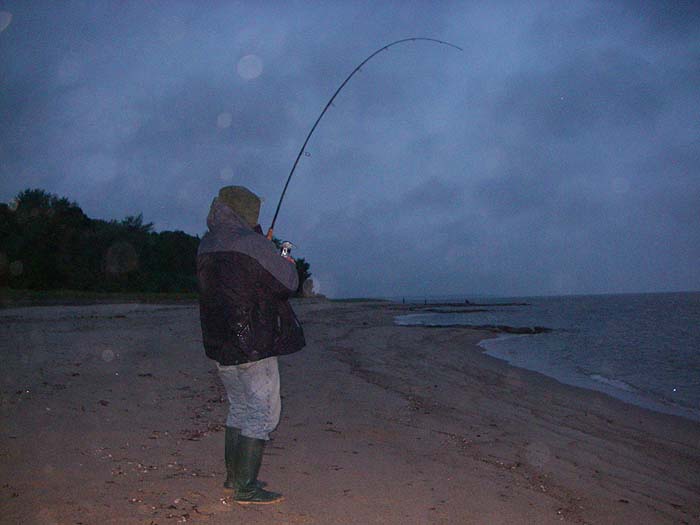
How's that for a bass?
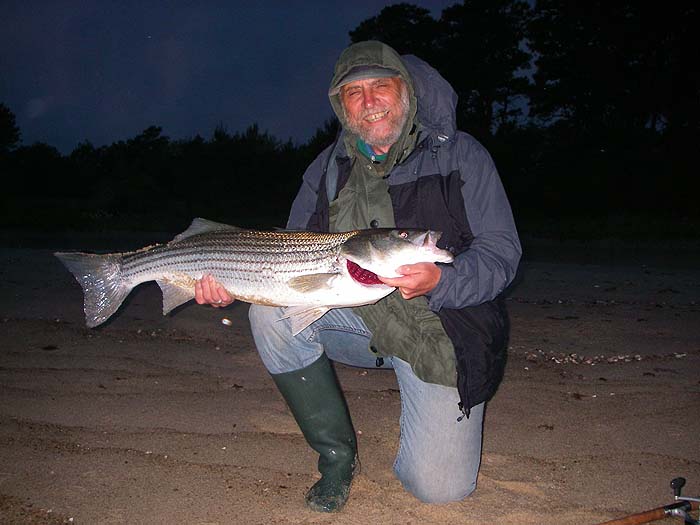
Weedy margin.
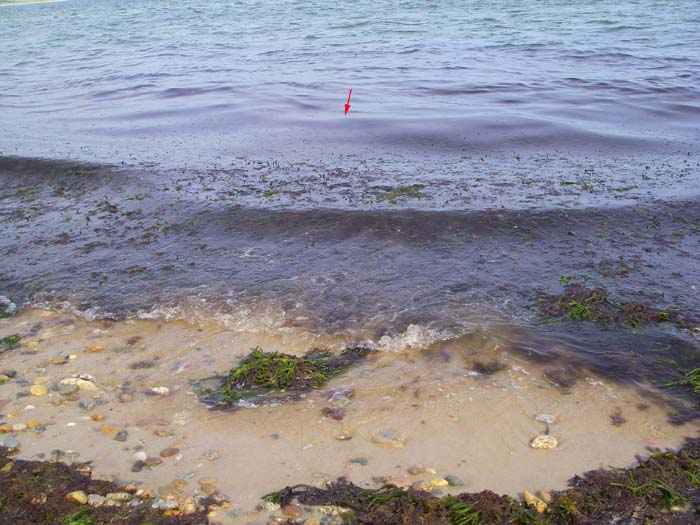
Nice bass.
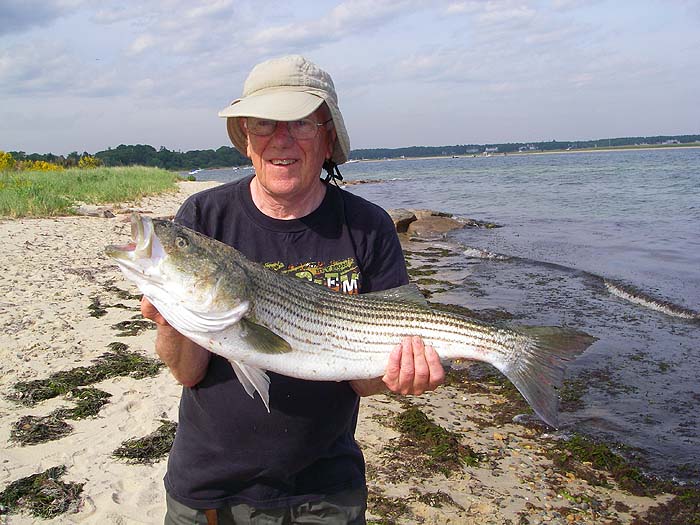
Bait caught.
